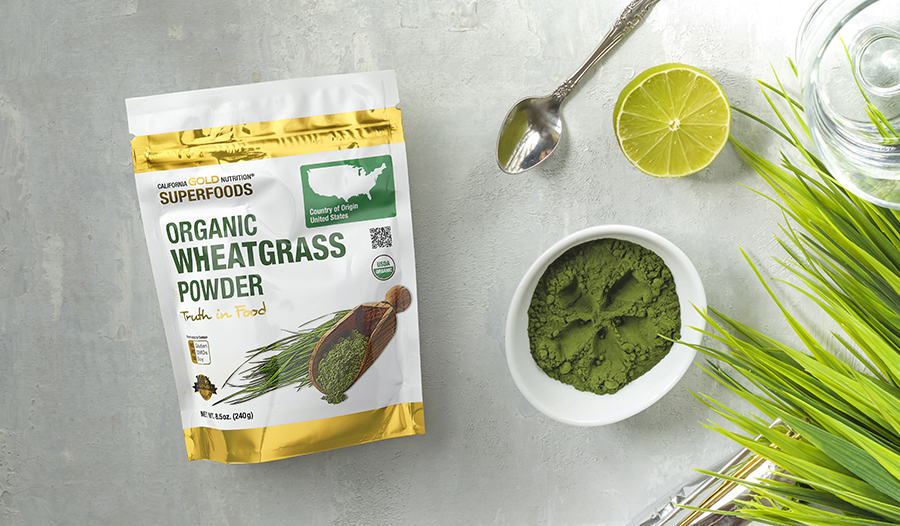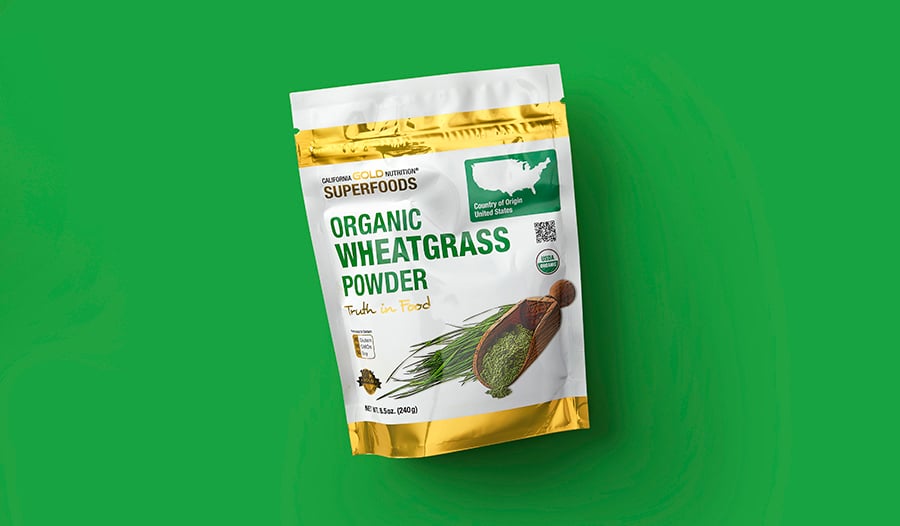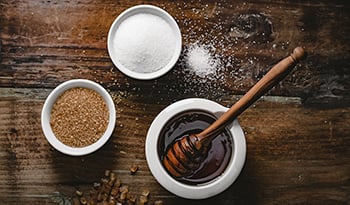5 Health Benefits of Wheatgrass + Tips For How To Use It
DISCLAIMER:This blog does not intend to provide diagnosis...
- In this article:
- What Is Wheatgrass?
- Is Wheatgrass A Good Source of Nutrients?
- What Are the Health Benefits of Wheatgrass?
- How Do I Use Wheatgrass?
- Potential Side Effects of Wheatgrass
- Is Wheatgrass Gluten-Free?
- Food Safety with Wheatgrass

You’ve probably heard of wheatgrass or seen it in your local smoothie or juice shop. Typically you can find wheatgrass in the form of juice or a wellness shot.
Wheatgrass has been around since the 1940s when it was introduced by Ann Wigmore, raw food and holistic health practitioner. She believed that wheatgrass could cure a multitude of diseases and that wheatgrass could detoxify the body. In 1982, she was sued by the attorney general of Massachusetts for promoting wheatgrass as a cure for diabetes. She was sued again in 1988 for falsely claiming that wheatgrass could cure AIDS and sold an “energy enzyme soup” that she promoted as a way to clear the syndrome from the body.
Though wheatgrass is not individually responsible for curing diseases, it may still have positive health implications.
What Is Wheatgrass?
Wheatgrass is the young grass from a wheat plant. It is a thick grass, similar to straw, but is bright green in color. One of the main reasons for growing wheatgrass is that farmers give it to livestock to eat.
Growing conditions that promote a good harvest of wheatgrass are found in regions throughout Europe and the United States. It can also be grown indoors in a pot and grows like grass. It can be purchased already started or started from seeds that are sprouted. Once grown, it can be clipped with scissors and used in many different ways.
Is Wheatgrass A Good Source of Nutrients?
As you saw above, wheatgrass has been promoted for claims that cannot be supported. But there are many benefits that wheatgrass does provide. It is an excellent source of a variety of vitamins and minerals, especially vitamin A, vitamin C, and vitamin E. Vitamin A and E are both fat-soluble vitamins that have antioxidant properties. Antioxidants are found in many foods and are important to include as they help keep cells healthy.
Wheatgrass is also high in the following vitamins and minerals:
- Iron is a molecule the body uses to make a protein that allows red blood cells to carry oxygen throughout the body.
- Magnesium is a mineral found not only in humans but in the Earth and plants as well. Nearly 60% of magnesium in the body is found in bones and is important for helping the body with biochemical reactions.
- Calcium is not only important in building and maintaining strong bones, it also plays a vital role in the proper function of your heart and muscles.
- Amino acids make up proteins that are needed to build and repair cells and tissues.]
What Are the Health Benefits of Wheatgrass?
1. Wheatgrass May Reduce Inflammation
Wheatgrass may help reduce inflammation. Inflammation is the body’s natural response to prevent harm. There are two types of inflammation—chronic and acute. Acute inflammation is when you get a cut on your hand or foot. Chronic inflammation can come from smoking, high cholesterol, and many other conditions. Having chronic inflammation can lead to disease and shorter life expectancy. One test-tube study showed that wheatgrass can inhibit the activity of a protein that causes inflammation.
2. Wheatgrass Potentially Lowers Cholesterol
Cholesterol is a wax-like substance that comes from your body or from outside factors such as animal products (meat, cheese, or dairy). It is something that your body needs to function properly, but having too much cholesterol may cause problems, including increasing your risk for cardiovascular disease.
In one animal study, they found that those given wheatgrass juice had a reduction in total “bad” LDL cholesterol levels. Another animal study done over 10-weeks showed improvement in “good” HDL cholesterol. These results are leading scientists in the right direction, but more research is needed in this area to come to any definitive conclusions.
3. Wheatgrass May Improve Your Immune System
The immune system plays an important role in keeping the body healthy year-round. We should not only focus on keeping the immune system healthy during cold and flu season but every day in between as well. Because of the high antioxidant content in wheatgrass, it may have a positive effect on the immune system overall.
4. Wheatgrass is High in Chlorophyll
You may remember the term chlorophyll from science class. It is responsible for giving plants their green color and helps absorb energy from the sun. The greener the plant is, the more chlorophyll it has. Not only does chlorophyll give plants a beautiful color, it also gives them many health benefits as well such as antioxidant properties, promoting healthy skin, and possible wound healing. Some may claim chlorophyll acts as a natural deodorizer, but these claims have been debunked.
5. Wheatgrass and Digestive Health
Fiber is an important nutrient that helps keep the gut healthy. One tablespoon of wheatgrass provides four grams or 14% of the daily value for fiber. For healthy individuals, 25 grams of fiber is recommended for women and 38 grams of fiber is recommended for men. Lack of fiber in the diet can cause constipation and other gastrointestinal problems.
How Do I Use Wheatgrass?
Wheatgrass is grass and unfortunately, it tastes like grass. The flavor is often very powerful and some find it hard to stomach. Because of the taste factor, you will often see wheatgrass paired with sweet foods such as fruit or in a small shot that can be over quickly. Wheatgrass is one of the longest-standing wellness shots on the market. You can find it fresh, in powder form, or mixed into a wellness shot or juice.
Potential Side Effects of Wheatgrass
There are no significant adverse effects to using wheatgrass. Some people have reported symptoms like nausea, headache, and diarrhea after using wheatgrass in capsule or juice forms. If any symptoms occur, speaking with a medical professional is advised.
Is Wheatgrass Gluten-Free?
Wheatgrass is a sprouted leaf from the wheat plant. Despite the name, wheatgrass is a gluten-free food. However, it may have been contaminated during processing, making it susceptible to cross-contamination, which may be very dangerous for those with celiac disease. If gluten is a food of concern, it’s always best to check with the manufacturer to ensure safety.
Food Safety with Wheatgrass
If purchasing wheatgrass, be sure to buy from a trusted supplier. Because it is grown in the soil or water and eaten raw, the risk of contamination can be high. Wheatgrass can be susceptible to mold and harmful bacteria depending on the growing conditions. If growing wheatgrass at home, inspect the grass before use to spot mold or any abnormality prior to consuming. Those who are pregnant or nursing are advised to not consume wheatgrass due to the possibility of food-borne illness. Anyone with a wheatgrass allergy should also avoid the consumption of wheatgrass in any form.
Wheatgrass poses many possible health benefits but the reality is that there haven’t been enough research studies to concretely prove them. Unfortunately, many health benefits for wheatgrass do not have sufficient evidence to support the claims. There are no extreme dangers of using wheatgrass, but If you want to add wheatgrass into your regimen, be sure to consult with your primary care provider prior to introducing it.
References:
- Bar-Sela G, Cohen M, Ben-Arye E, Epelbaum R. The Medical Use of Wheatgrass: Review of the Gap Between Basic and Clinical Applications. Mini Rev Med Chem. 2015;15(12):1002-10. doi: 10.2174/138955751512150731112836. PMID: 26156538.
- Subramoniam, A., Asha, V. V., Nair, S. A., Sasidharan, S. P., Sureshkumar, P. K., Rajendran, K. N., Karunagaran, D., & Ramalingam, K. (2012). Chlorophyll revisited: anti-inflammatory activities of chlorophyll a and inhibition of expression of TNF-α gene by the same. Inflammation, 35(3), 959–966. https://doi.org/10.1007/s10753-011-9399-0
- Kothari, S., Jain, A. K., Mehta, S. C., & Tonpay, S. D. (2011). Hypolipidemic effect of fresh Triticum aestivum (wheat) grass juice in hypercholesterolemic rats. Acta poloniae pharmaceutica, 68(2), 291–294.
- Sethi, J., Yadav, M., Dahiya, K., Sood, S., Singh, V., & Bhattacharya, S. B. (2010). Antioxidant effect of Triticum aestivium (wheat grass) in high-fat diet-induced oxidative stress in rabbits. Methods and findings in experimental and clinical pharmacology, 32(4),
- 233–235. https://doi.org/10.1358/mf.2010.32.4.1423889
- FoodData Central Search Results. FoodData Central. (n.d.). https://fdc.nal.usda.gov/fdc-app.html#/food-details/601871/nutrients.

 By Rhyan Geiger, RDN
By Rhyan Geiger, RDN



